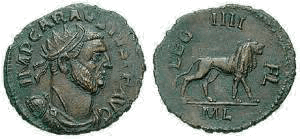Carausius
Marcus Aurelius
Mausaeus Carausius was born in Holland and joined the Roman Army as
a young man.
He led a distinguished career
and in 286 AD was given command of the Roman
Navy, called the Classis Brittanica, based in the English Channel to
deal with the increasing problem of raids on the
coasts of England and France by Saxons.
Painting
in 1672 by Lorenzo Sastro of roman ships engaged in naval battle
 picture
courtesy of Wikimedia Commons
picture
courtesy of Wikimedia Commons
There were rumours that
Carausius used his position to enrich himself by making deals with
the Pirates.
Whether this was true we
won't know but history records that he had a very poor record at
intercepting pirates on their way to plunder but a very high rate of
intercepting them and their booty on their way home after pillaging
a coastal town.
In 287 word of his behaviour
reached the ears of Emperor Maximian who ordered his arrest and
execution.
Carausius heard of the order
before it could be executed and moved his fleet plus a Roman Legion
stationed in France, all merchant vessels that were in the French
Ports and many mercenaries to England.
Stripped of the fleet at a
time when the Roman Empire was under threat from several sides there
was little that Emperor Maximian could do.
There is no surviving documentation to tell us how Carausius dealt
with the Roman troops in England although by this time most of the
troops would be recruited from parts of the Roman Empire largely
from Holland and Germany so they may well have joined his cause
rather than battles taking place.
By the latter part of 287
Carausius was styling himself Emperor of Britain and wore the
Imperial Purple clothing.
He also issued coins bearing
his head.

Emperor Maximian planned an
invasion of Britain in 288 but a combination of bad weather and a
superior strategy by Carausius foiled the plan.
At this point negotiations
took place and a peaceful settlement was agreed that allowed
Carausius to rule Britain whilst acknowledging the figurehead role
of Emperor Maximian.
From this point Carausius
fortified England by completing the line of 9 forts that included
Othona and built many more merchant and warships.
Many scholars believe that
Othona was completed before Carausius took up his post with the
Classis Brittanica although perhaps the majority believe that the
forts south of the Thames were in place and that Carausius added
Othona and forts north of the Thames to complete the line.
Othona had a quay on its
seaward side to link up with the naval vessels that were so key to
Carausius's power.
Whether he built Othona or
used it there is little doubt that it was one of the key defensive
locations in his empire.
No doubt that he would have
been a regular visitor to ensure they loyalty and efficiency of his
garrison.
In the Decline and Fall of
the Roman Empire, Edward Gibbon described the success of Carausius
in the next period.
Carausius still preserved the possession of Bologne and the adjacent
country. His fleets rode triumphant in the Channel, commanded the
mouths of the Seine and of the Rhine, ravaged the coats of the ocean
and diffused beyond the Columns of Hercules, the terror of his name.
Under his command Britain, destined in a future age to obtain the
empire of the sea, already assumed its natural and respectable
station of a maritime power.
The Romans hit back in AD 293
when a Roman army under Constantius Chlorus reclaimed France from
various rebels including Bologne and then marched through German and
Holland taking the European bases of Carausius.
Chlorus then began planning
an invasion of Britain.
This undermined the authority
of Carausius who was assassinated by Allectus who was his deputy.
Allectus immediately assumed
power but his reign was short lived before he was killed by the
Roman Commanders and once again Roman rule was felt in Britain.
Click
here
to visit a web page with details of the Roman Fort of Othona at
Bradwell on Sea



